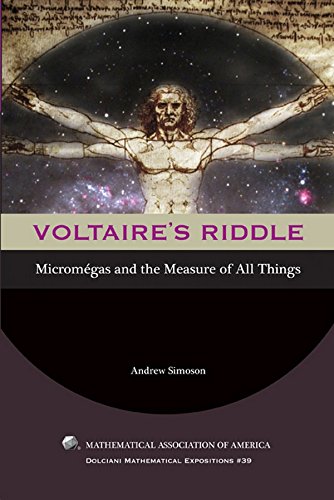Artículos relacionados a Voltaire's Riddle Hardback: Micromegas and the...
Voltaire's Riddle Hardback: Micromegas and the Measure of All Things (Dolciani Mathematical Expositions) - Tapa dura

An exploration of Voltaire's Micromégas, the story of a giant from a planet of Sirius who visits a French expedition on its return from testing Newton's theory of gravity in the polar regions. This book suggests some possible answers to Voltaire's riddle, and presents the related mathematics behind the expedition.
"Sinopsis" puede pertenecer a otra edición de este libro.
Contraportada:
Did you know that Voltaire was the first to publish the legend of Isaac Newton discovering gravity upon seeing an apple fall? That he tried for about eight years to be a mathematician? That in 1752 he wrote Micromégas, a story about a French expedition to the arctic (1736—7) whose purpose was to test Newton’s controversial theories about gravity? This book is about that story and its underlying mathematics. Briefly, an alien giant visits the earth and encounters the expedition returning from north of the Baltic Sea. Their ensuing dialogue ranges from measurements of the very small to the very large, from gnats and micro-organisms to planets and stars, from man’s tendency to make war to dreams of understanding his own spirit. At the end of their conversation, the giant gives man a book with the answers to all things. But when they open it, it is blank. That is the riddle of this book. What does such an ending mean? As a series of vignettes and chapters, we give some riddle resolutions. The vignettes---requiring no special mathematical knowledge---describe the people, traditions, and events of the expedition and story. The chapters---accessible to anyone with a background in undergraduate linear algebra, vector calculus, and differential equations---show why a rotating earth must be flattened at the poles, why the tip of earth’s polar axis traces out a curve with period of nearly twenty-six thousand years, why the path of a small black hole dropped at the earth’s equator must be a hypocycloid, why an old problem studied by Maupertuis---the leader of the French expedition---is a pursuit curve, and why in measuring phenomena we sometimes get it wrong. All in all, this book is a case study in how mathematical and scientific knowledge becomes common knowledge.
Biografía del autor:
Andrew Simoson earned a Ph.D. in Mathematics under Leonard Asimow at the University of Wyoming in 1979, working on extensions of separating theorems in functional analysis. Since then, he has been chairman of the mathematics department at King College in Bristol, Tennessee, and has authored over thirty papers in various mathematical journals. He has twice been a Fulbright professor, at the University of Botswana, 1990–91, and at the University of Dar es Salaam in Tanzania, 1997–98.
"Sobre este título" puede pertenecer a otra edición de este libro.
- EditorialThe Mathematical Association of America
- Año de publicación2010
- ISBN 10 0883853450
- ISBN 13 9780883853450
- EncuadernaciónTapa dura
- Número de páginas396
Comprar nuevo
Ver este artículo
EUR 75,29
Gastos de envío:
EUR 11,66
De Reino Unido a Estados Unidos de America
Los mejores resultados en AbeBooks
Voltaire's Riddle: Micromegas and the Measure of All Things
Publicado por
Mathematical Assn of Amer
(2010)
ISBN 10: 0883853450
ISBN 13: 9780883853450
Nuevo
Tapa dura
Cantidad disponible: 1
Librería:
Valoración
Descripción Hardcover. Condición: Brand New. 377 pages. 9.00x6.00x1.00 inches. In Stock. Nº de ref. del artículo: __0883853450
Comprar nuevo
EUR 75,29
Convertir moneda
Gastos de envío:
EUR 11,66
De Reino Unido a Estados Unidos de America
Destinos, gastos y plazos de envío

